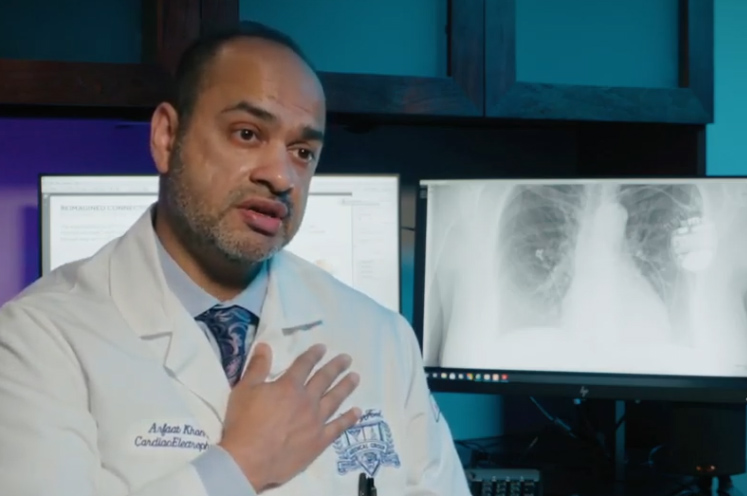Why choose Henry Ford Health for a pacemaker or defibrillator?
We have decades of experience helping people who need pacemakers or defibrillators. Here you’ll find:
- Innovation: We were the first heart program in Michigan to implant subcutaneous defibrillators. We’re also leading the way with research into new device options. Learn more about research and clinical trials for arrhythmia. Range of services: Not only do we place new devices, we also fix problems with existing implants. Sometimes the leads, or wires, become damaged. They may also develop an infection. In these cases, we need to remove the leads, a delicate process requiring an experienced electrophysiologist. Find out more about lead extraction.
- Specialized labs: Our electrophysiology (EP) labs enable us to test and monitor your heart’s electrical activity during an implant procedure. We can determine precisely where to place leads for cardiac devices.
- Ongoing care: Experts at our Device Clinic provide lifelong follow-up care for people with ICDs and pacemakers. We do most of this monitoring remotely so you don’t have to worry about extra appointments. Learn more about our cardiac device monitoring.
- Partnership with your doctor: We make it easy for you to receive follow-up care from your primary care doctor or community cardiologist. We also train doctors and nurses in rural areas who care for people with devices.
Pacemakers
A pacemaker is a small, battery-powered device that controls your heart’s rhythm. You might need a pacemaker for many of the arrhythmias we treat, including if your heartbeat is:
- Too fast, described as tachycardia
- Too slow, described as bradycardia
- Erratic, described as fibrillation
We use various types of pacemakers. A single chamber pacemaker controls the heart’s right bottom chamber (ventricle). A dual chamber pacemaker controls both the upper (atrium) and lower (ventricle) chambers on the right side of your heart.
How it works:
- We use tiny incisions to implant a pacemaker under the skin in the chest.
- The pacemaker connects to small wires, or leads, that we place inside the heart.
- When the device senses an abnormal rhythm, it sends a signal to the leads.
- The leads create electrical signals that reset your heart’s rhythm.
Defibrillators
A defibrillator, or ICD, is a battery-powered device that can deliver a shock if your heart’s rhythm gets out of sync. Most new ICDs work as both defibrillators and pacemakers.
We may recommend an ICD if your heart beats too fast or has an erratic rhythm. We may also recommend one if you have a heart condition that puts you at risk of developing a life-threatening heart rhythm disorder. These devices are common treatments for potentially dangerous heart rhythm disorders such as ventricular fibrillation and ventricular tachycardia. They can prove life saving for people with these arrhythmias.
How ICDs work:
- We typically insert the ICD under the skin, below the collarbone.
- We run wires, or leads, from the ICD to the heart.
- The device continuously monitors your heart rhythm and is ready to immediately deliver a potentially life-saving shock.
- If a dangerous arrhythmia occurs, the ICD restores a normal heart rhythm.
Leadless pacemakers and subcutaneous defibrillators
Leadless pacemakers don’t have the wires found in traditional devices. We implant leadless pacemakers directly into the heart. Currently, we use leadless pacemakers for arrhythmias in the right bottom chamber (ventricle) of the heart.
Subcutaneous defibrillators (S-ICDs) use a pulse generator implanted near your armpit. The generator is connected to a lead (wire) that runs below your skin above your breastbone. The pulse generator contains a tiny battery-powered computer that senses your heart’s electrical activity.
Subcutaneous defibrillators and leadless pacemakers are new technologies, but they do have several advantages:
- Reduced chance of serious complications from infection
- Fewer complications down the road because there are no wires that travel inside your bloodstream or directly touch your heart
Other specialized cardiac devices
We offer many specialized pacemakers and defibrillators, many through clinical trials. Specialized treatments we offer include:
- Cardiac resynchronization therapy (CRT): CRT helps the heart pump normally for people with congestive heart failure. It’s also called biventricular pacing because it helps both lower chambers (ventricles) of the heart.
- Biventricular defibrillators: Some people with heart failure can benefit from a device that combines CRT with a defibrillator.
- His-Bundle pacing: With this specialized procedure, we implant a pacing wire or lead close to the heart’s own natural wiring. It’s an alternative to biventricular pacing that can help people who have bradycardia or heart failure.
- Left atrial appendage closure: We use a special device to reduce the risk of stroke in people with atrial fibrillation. Learn more about left atrial appendage closure.
.svg?iar=0&hash=F6049510E33E4E6D8196C26CCC0A64A4)

/hfh-logo-main--white.svg?iar=0&hash=ED491CBFADFB7670FAE94559C98D7798)
